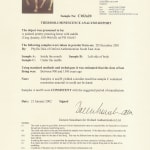T'ang Terracotta Sculpture of a Horse with a Detachable Saddle, 618 CE - 906 CE
Painted Terracotta
height 66.7 cm
height 26 1/4 in
height 26 1/4 in
H.713
The Tang Dynasty was an era of unrivalled wealth and luxury. The country was successfully reunified and the borders were expanded, pushing Chinese influence into new lands. Confucianism became a...
The Tang Dynasty was an era of unrivalled wealth and luxury. The country was successfully reunified and the borders were expanded, pushing Chinese influence into new lands. Confucianism became a semi-religious instrument of the state; yet Buddhism continued to flourish, spreading into Korea and Japan. The arts reached new levels of sophistication. Poetry and literature flourished under the enlightened rulers. The Silk Road brought fortunes into China. Precious treasures were imported on the backs of camels from far away lands and bartered for Chinese silk, medicinal herbs, and pungent spices. Tang China was a multicultural empire where foreign merchants from across Central Asia and the Middle East settled in the urban centers, foremost among them the thriving capital of Chang’an (modern X’ian), a bustling cosmopolitan center of over two million inhabitants. Foreign traders lived next to native artisans and both thrived. New ideas and exotic artistic forms followed alongside. The Tang Dynasty was a cultural renaissance where many of the forms and objects we now associate with China were first created. Moreover, this period represents one of the greatest cultural outpourings in human history.
The great influence of the horse throughout the history of China cannot be underestimated. In fact, the ancient unification of the Chinese Empire was due in large part to the horse. Their rapid mobility allowed for quick communication between far away provinces. Likewise, the military role of horses aided in the conquest and submission of distant lands. The need to import stronger, faster steeds from Central Asia (as opposed to the native Mongol pony) led to the creation of the Silk Road. The importance of the horse in the history and culture of China can be viewed, in part, through the artistic legacy of this great civilization. In sculpture, painting, and literature, horses were glorified and revered, believed to be relatives of dragons, a theory reflecting their sacred status within society. During the T’ang Dynasty, the adoration of the horse can be seen through their burial art. Horse models excavated from mausoleums of the period are among the most splendid and easily recognizable works of Chinese art.
This impressive, large sculpture of a horse still retains much of its original white pigment in tact. However, even more impressive, is the removable saddle that graces his back. Painted in bright orange, this textured saddle may have once supported a rider who is now lost to us. A hole in the rear would have once presumable been filled with real horsehair. Traces of polychrome are also visible inside the nose and along the mouth. The horse raises one leg in the air, his head is turned to the side and his mouth is slightly ajar. All these features are sought after by collectors. When one imagines this horse as it might have originally appeared, with vibrant hues, a similarly modeled rider, and tail of real horsehair, the illusion would have been uncanny. This gorgeous sculpture is a testament to the admiration and adoration the Chinese had for this marvelous creatures. Although they were an integral part in the expansion and defense of the empire, they were equally regarded for their beauty and grace as revealed by this sculpture.
The great influence of the horse throughout the history of China cannot be underestimated. In fact, the ancient unification of the Chinese Empire was due in large part to the horse. Their rapid mobility allowed for quick communication between far away provinces. Likewise, the military role of horses aided in the conquest and submission of distant lands. The need to import stronger, faster steeds from Central Asia (as opposed to the native Mongol pony) led to the creation of the Silk Road. The importance of the horse in the history and culture of China can be viewed, in part, through the artistic legacy of this great civilization. In sculpture, painting, and literature, horses were glorified and revered, believed to be relatives of dragons, a theory reflecting their sacred status within society. During the T’ang Dynasty, the adoration of the horse can be seen through their burial art. Horse models excavated from mausoleums of the period are among the most splendid and easily recognizable works of Chinese art.
This impressive, large sculpture of a horse still retains much of its original white pigment in tact. However, even more impressive, is the removable saddle that graces his back. Painted in bright orange, this textured saddle may have once supported a rider who is now lost to us. A hole in the rear would have once presumable been filled with real horsehair. Traces of polychrome are also visible inside the nose and along the mouth. The horse raises one leg in the air, his head is turned to the side and his mouth is slightly ajar. All these features are sought after by collectors. When one imagines this horse as it might have originally appeared, with vibrant hues, a similarly modeled rider, and tail of real horsehair, the illusion would have been uncanny. This gorgeous sculpture is a testament to the admiration and adoration the Chinese had for this marvelous creatures. Although they were an integral part in the expansion and defense of the empire, they were equally regarded for their beauty and grace as revealed by this sculpture.



